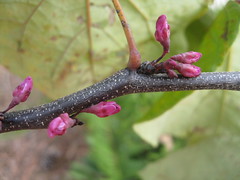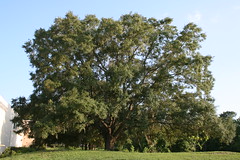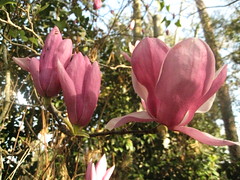Arbor Day is a great way to recognize the importance of trees and the benefits they provide. Planting a tree doesn't just make your landscape more attractive, it also helps reduce air pollution and conserves energy. If you do plant a tree, consider a native, such as the State tree of Florida, the sabal palm.
My Favorite Trees
Eastern Redbud - Eastern Redbuds grow well in some shade in Florida. Best growth occurs in a light, rich, moist soil but Eastern Redbud adapts well to a variety of soil including sandy or alkaline.
Trees look better when they receive some irrigation in summer dry spells. Its native habitat ranges from stream bank to dry ridge, demonstrating its adaptability.
Trees are sold as single or multistemmed. Young trees are easiest to transplant and survive best when planted in the spring or fall. Containerized trees can be planted anytime.
The beans provide food for some birds. Trees are short-lived but provide a wonderful show in the spring and fall.

Oak Trees (specifically Live Oaks) - Oaks are large trees that provide shade in the summer and fuel for fires in the winter. The nineteen species of oaks native to Florida include many of our most common and attractive trees, like Shumard and live oaks.
These trees provide valuable wildlife habitat and food, and some offer showy autumn foliage. Oaks are typically strong and durable and have a long lifespan.
When pruned properly, many of the different varieties of oaks are fairly hurricane-resistant. Oaks grow relatively quickly and can provide shade for your home.
Many oaks are deciduous, meaning that they drop their leaves during the winter. Live oak is evergreen, as it gets its new leaves about the same time that it drops its old leaves.

Magnolia - Magnolias come in all shapes and sizes, but perhaps the most well-known magnolia in Florida is the Southern magnolia, Magnolia grandiflora.
These stately trees can grow up to 90 feet tall, depending on the cultivar, and have lustrous, evergreen foliage that makes a great backdrop for other garden plants. In the spring and summer, Southern magnolias produce creamy white flowers that have a lemony smell and can be as large across as dinner plates.
Southern magnolias are often planted as specimen trees, but a row of magnolias can also make a great screen for blocking unsightly views or establishing a boundary between adjoining properties. Some Southern magnolias can even be trained as an espalier plant if you’re willing to invest the time!
This is a great picture of a Saucer Magnolia flower instead of a Southern Magnolia. But, I think it's really pretty and has great color.

Don’t wait another day--plant a tree today!


No comments:
Post a Comment